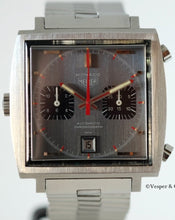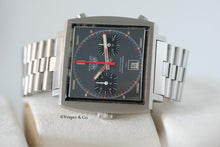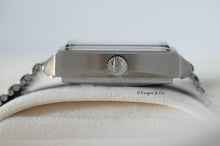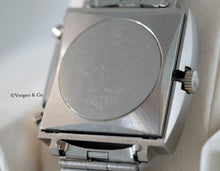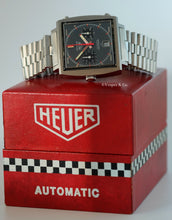
Heuer. A Stainless Steel Square-Shaped Chronograph Wristwatch with Date and Bracelet
Model: Monaco
Ref: 1133G
Circa: 1970
Automatic jeweled movement, gray dial, applied baton and square numerals with inner red baton markings and luminous accents, red hands with luminous fill and triangular red tips, inner minute divisions, central red chronograph hand, two painted black chronograph registers for 12 hour and 30 minute registers, date window at 6 o’clock, water-resistant square-shaped case with obtuse sides, two chronograph buttons in the band between 1 and 2 o’clock and 4 and 5 o’clock, crown at 9 o’clock, snap back engraved “Tool No. 033”, stainless steel Heuer bracelet and clasp, case dial, and movement signed
40mm
Accompanied by a Heuer presentation box
More about Heuer:
The Heuer Monaco is immediately recognizable for its connection with actor Steve McQueen, who wore the model during filming the 1971 movie Le Mans. While McQueen wore the ref. 1133B with its striking blue dial, other early Monaco references are equally popular and collectible.
Towards the end of the 1960’s, Heuer was preparing to launch the Caliber 11 chronograph movement, the first self-winding chronograph in the world. The Monaco case was presented to Heuer in 1968 from casemaker Piquerez, and a deal was made for the case to be exclusive to their brand. While the movement was to be launched at the same time in the Monaco, Carrera and Autavia models, Heuer hoped that the unique shape of the Monaco case would make it stand out not only from the other Heuer chronograph models, but from the chronographs launched at the same time by competing brands.
The 1133G model was produced from 1970 to 1974. Several dial variants were produced, with either gray or black sub-dials, and the subdials were either painted on or sunken. With the more subtle gray dial (as opposed to the bright blue of the 1133B), the 1133G has a refined charisma, and wears just as well on the wrist today as it did over forty years ago. The present example is in mint condition, with sharp case facets, and original factory brushed texture.








